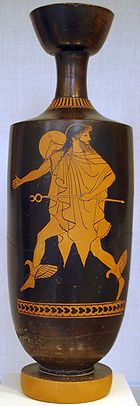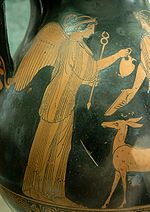
Caduceus
Encyclopedia


Hermes
Hermes is the great messenger of the gods in Greek mythology and a guide to the Underworld. Hermes was born on Mount Kyllini in Arcadia. An Olympian god, he is also the patron of boundaries and of the travelers who cross them, of shepherds and cowherds, of the cunning of thieves, of orators and...
in Greek mythology
Greek mythology
Greek mythology is the body of myths and legends belonging to the ancient Greeks, concerning their gods and heroes, the nature of the world, and the origins and significance of their own cult and ritual practices. They were a part of religion in ancient Greece...
. The same staff was also borne by heralds in general, for example by Iris
Iris (mythology)
In Greek mythology, Iris is the personification of the rainbow and messenger of the gods. As the sun unites Earth and heaven, Iris links the gods to humanity...
, the messenger of Hera
Hera
Hera was the wife and one of three sisters of Zeus in the Olympian pantheon of Greek mythology and religion. Her chief function was as the goddess of women and marriage. Her counterpart in the religion of ancient Rome was Juno. The cow and the peacock were sacred to her...
. It is a short staff entwined by two serpents, sometimes surmounted by wings. In Roman iconography it was often depicted being carried in the left hand of Mercury
Mercury (mythology)
Mercury was a messenger who wore winged sandals, and a god of trade, the son of Maia Maiestas and Jupiter in Roman mythology. His name is related to the Latin word merx , mercari , and merces...
, the messenger of the gods, guide of the dead and protector of merchants, shepherds, gamblers, liars and thieves.
As a symbolic object it represents Hermes (or the Roman Mercury), and by extension trades, occupations or undertakings associated with the god. In later Antiquity
Classical antiquity
Classical antiquity is a broad term for a long period of cultural history centered on the Mediterranean Sea, comprising the interlocking civilizations of ancient Greece and ancient Rome, collectively known as the Greco-Roman world...
the caduceus provided the basis for the astrological symbol
Astrological symbols
Astrological symbols are images used in various astrological systems to denote relevant objects. A number of such images are shown below.-History and origin:...
representing the planet Mercury
Mercury (planet)
Mercury is the innermost and smallest planet in the Solar System, orbiting the Sun once every 87.969 Earth days. The orbit of Mercury has the highest eccentricity of all the Solar System planets, and it has the smallest axial tilt. It completes three rotations about its axis for every two orbits...
. Thus, through its use in astrology
Astrology
Astrology consists of a number of belief systems which hold that there is a relationship between astronomical phenomena and events in the human world...
and alchemy
Alchemy
Alchemy is an influential philosophical tradition whose early practitioners’ claims to profound powers were known from antiquity. The defining objectives of alchemy are varied; these include the creation of the fabled philosopher's stone possessing powers including the capability of turning base...
, it has come to denote the elemental metal
Mercury (element)
Mercury is a chemical element with the symbol Hg and atomic number 80. It is also known as quicksilver or hydrargyrum...
of the same name.
By extension of its association with Mercury/Hermes, the caduceus is also a recognized symbol of commerce and negotiation, two realms in which balanced exchange and reciprocity are recognized as ideals. This association is ancient, and consistent from the Classical period to modern times. The caduceus is also used as a symbol representing printing, again by extension of the attributes of Mercury (in this case associated with writing and eloquence).
The caduceus is sometimes mistakenly used as a symbol of medicine and/or medical practice
Caduceus as a symbol of medicine
The caduceus, the traditional symbol of Hermes featuring two snakes around an often winged staff, is often mistakenly used as a symbol of medicine, especially in the United States of America. The two-snake caduceus design has ancient and consistent associations with commerce, eloquence, trickery...
, especially in North America
North America
North America is a continent wholly within the Northern Hemisphere and almost wholly within the Western Hemisphere. It is also considered a northern subcontinent of the Americas...
, because of widespread confusion with the traditional medical symbol, the rod of Asclepius
Rod of Asclepius
The rod of Asclepius , also known as the asklepian, is an ancient symbol associated with astrology, the Greek god Asclepius, and with medicine and healing. It consists of a serpent entwined around a staff. The name of the symbol derives from its early and widespread association with Asclepius, the...
, which has only a single snake and no wings.
Origin and comparative mythology


Lewis Richard Farnell
Lewis Richard Farnell
Lewis Richard Farnell FBA was a classical scholar and Oxford academic, where he served as Vice-Chancellor from 1920 to 1923.Lewis Farnell was born in Salisbury, southern England, in 1856. He was educated at the City of London School and Exeter College, Oxford, where he graduated with a first class...
(1909) in his study of the cult of Hermes assumed that the two snakes had simply developed out of ornaments of the shepherd's crook used by heralds as their staff. This view has been rejected by later authors pointing to parallel iconography in the Ancient Near East.
It has been argued that the staff or wand entwined by two snakes was itself representing a god in the pre-anthropomorphic era. Like the herm
Herma
A Herma, commonly in English herm is a sculpture with a head, and perhaps a torso, above a plain, usually squared lower section, on which male genitals may also be carved at the appropriate height...
or priapus
Priapus
In Greek mythology, Priapus or Priapos , was a minor rustic fertility god, protector of livestock, fruit plants, gardens and male genitalia. Priapus is marked by his absurdly oversized, permanent erection, which gave rise to the medical term priapism...
, it would thus be a predecessor of the anthropomorphic Hermes of the classical era.
Ancient Near East
William Hayes WardWilliam Hayes Ward
William Hayes Ward was an American clergyman, editor, and Orientalist, born at Abington, Mass.He graduated from Phillips Academy, Andover, in 1852, Amherst College in 1856, and the Andover Theological Seminary in 1859. He served as pastor of a church at Oskaloosa, Kans. in 1859-60, and as...
(1910) discovered that symbols similar to the classical caduceus sometimes appeared on Mesopotamian cylinder seals. He suggested the symbol originated some time between 3000 and 4000 BCE, and that it might have been the source of the Greek caduceus. A.L. Frothingham incorporated Dr. Ward's research into his own work, published in 1916, in which he suggested that the prototype of Hermes was an "Oriental deity of Babylonian extraction" represented in his earliest form as a snake god. From this perspective, the caduceus was originally representative of Hermes himself, in his early form as the Underworld god Ningishzida
Ningishzida
Ningishzida is a Mesopotamian deity of the underworld. His name in Sumerian is translated as "lord of the good tree" by Thorkild Jacobsen....
, "messenger" of the "Earth Mother".
The caduceus is mentioned in passing by Walter Burkert
Walter Burkert
Walter Burkert is a German scholar of Greek mythology and cult.An emeritus professor of classics at the University of Zurich, Switzerland, he also has taught in the United Kingdom and the United States...
as "really the image of copulating snakes taken over from Ancient Near Eastern tradition".
In Egyptian iconography, the Djed
Djed
The djed symbol is a pillar-like ancient Egyptian symbol representing stability. It has been interpreted as the backbone of the Egyptian god Osiris, especially in the form Banebdjedet . Djedu is the Egyptian name for Busiris, a centre of the cult of Osiris...
pillar is depicted as containing a snake in a frieze of the Dendera Temple complex
Dendera Temple complex
Dendera Temple complex, . located about 2.5 km south-east of Dendera, Egypt. It is one of the best-preserved temple complexes in Egypt...
.
The rod of Moses
Moses
Moses was, according to the Hebrew Bible and Qur'an, a religious leader, lawgiver and prophet, to whom the authorship of the Torah is traditionally attributed...
and the brazen serpent are frequently compared to the caduceus, especially as Moses is acting as a messenger of God to the Pharaoh at the point in the narrative where he changes his staff into a serpent.
Mythology
The Homeric hymn to Hermes relates how Hermes offered his lyre fashioned from a tortoise shell as compensation for the cattle he stole from his half brother ApolloApollo
Apollo is one of the most important and complex of the Olympian deities in Greek and Roman mythology...
. Apollo in return gave Hermes the caduceus as a gesture of friendship.
The association with the serpent thus connects Hermes to Apollo
Apollo
Apollo is one of the most important and complex of the Olympian deities in Greek and Roman mythology...
, as later the serpent was associated with Asclepius
Asclepius
Asclepius is the God of Medicine and Healing in ancient Greek religion. Asclepius represents the healing aspect of the medical arts; his daughters are Hygieia , Iaso , Aceso , Aglæa/Ægle , and Panacea...
, the "son of Apollo".
The association of Apollo with the serpent is a continuation of the older Indo-European dragon
Dragon
A dragon is a legendary creature, typically with serpentine or reptilian traits, that feature in the myths of many cultures. There are two distinct cultural traditions of dragons: the European dragon, derived from European folk traditions and ultimately related to Greek and Middle Eastern...
-slayer motif. Wilhelm Heinrich Roscher
Wilhelm Heinrich Roscher
Wilhelm Heinrich Roscher was a German classical scholar. He is best known for his Lexicon, the Ausführliches Lexikon der griechischen und römischen Mythologie...
(1913) pointed out that the serpent as an attribute of both Hermes and Asclepius is a variant of the "pre-historic semi-chthonic serpent hero known at Delphi as Python
Python (mythology)
In Greek mythology, Python was the earth-dragon of Delphi, always represented in Greek sculpture and vase-paintings as a serpent. He presided at the Delphic oracle, which existed in the cult center for his mother, Gaia, "Earth," Pytho being the place name that was substituted for the earlier Krisa...
", who in classical mythology is slain by Apollo.
One Greek myth of origin
Etiology
Etiology is the study of causation, or origination. The word is derived from the Greek , aitiologia, "giving a reason for" ....
of the caduceus is part of the story of Tiresias
Tiresias
In Greek mythology, Tiresias was a blind prophet of Thebes, famous for clairvoyance and for being transformed into a woman for seven years. He was the son of the shepherd Everes and the nymph Chariclo; Tiresias participated fully in seven generations at Thebes, beginning as advisor to Cadmus...
, who found two snakes copulating and killed the female with his staff. Tiresias was immediately turned into a woman, and so remained until he was able to repeat the act with the male snake seven years later. This staff later came into the possession of the god Hermes, along with its transformative powers.
Another myth suggests that Hermes (or Mercury) saw two serpents entwined in mortal combat. Separating them with his wand he brought about peace between them, and as a result the wand with two serpents came to be seen as a sign of peace.
In Rome, Livy
Livy
Titus Livius — known as Livy in English — was a Roman historian who wrote a monumental history of Rome and the Roman people. Ab Urbe Condita Libri, "Chapters from the Foundation of the City," covering the period from the earliest legends of Rome well before the traditional foundation in 753 BC...
refers to the caduceator who negotiated peace arrangements under the diplomatic protection of the caduceus he carried.
Iconography
In some vase paintings ancient depictions of the Greek kerukeion are somewhat different from the commonly seen modern representation. These representations feature the two snakes atop the staff (or rod), crossed to create a circle with the heads of the snakes resembling horns. This old graphic form, with an additional crossbar to the staff, seems to have provided the basis for the graphical sign of Mercury (☿) used in Greek astrology from Late Antiquity.Use in alchemy and occultism
As the symbol of both the planetMercury (planet)
Mercury is the innermost and smallest planet in the Solar System, orbiting the Sun once every 87.969 Earth days. The orbit of Mercury has the highest eccentricity of all the Solar System planets, and it has the smallest axial tilt. It completes three rotations about its axis for every two orbits...
and the metal named for Mercury, the caduceus became an important symbol in alchemy
Alchemy
Alchemy is an influential philosophical tradition whose early practitioners’ claims to profound powers were known from antiquity. The defining objectives of alchemy are varied; these include the creation of the fabled philosopher's stone possessing powers including the capability of turning base...
.
The crucified serpent was also revived as an alchemical symbol for fixatio, and John Donne
John Donne
John Donne 31 March 1631), English poet, satirist, lawyer, and priest, is now considered the preeminent representative of the metaphysical poets. His works are notable for their strong and sensual style and include sonnets, love poetry, religious poems, Latin translations, epigrams, elegies, songs,...
(Sermons 10:190) uses "crucified Serpent" as a title of Jesus Christ.
Symbol of commerce
A simplified variant of the caduceus is to be found in dictionaries, indicating a “commercial term” entirely in keeping with the association of Hermes with commerce. In this form the staff is often depicted with two winglets attached and the snakes are omitted (or reduced to a small ring in the middle). The Customs Service of the former German Democratic RepublicGerman Democratic Republic
The German Democratic Republic , informally called East Germany by West Germany and other countries, was a socialist state established in 1949 in the Soviet zone of occupied Germany, including East Berlin of the Allied-occupied capital city...
employed the caduceus, bringing its implied associations with thresholds, translators, and commerce, in the service medals they issued their staff.
Misuse as Symbol of medicine
See also
- Aaron's rodAaron's rodAaron's rod refers to any of the staves carried by Moses' brother, Aaron, in the Old Testament of the Bible. The Bible tells how, along with Moses' rod, Aaron's rod was endowed with miraculous power during the Plagues of Egypt which preceded the Exodus...
- Bowl of HygieiaBowl of HygieiaBowl of Hygieia is one of the symbols of pharmacy. Hygieia was the Greek goddess of health.- Usage of symbol by pharmaceutical associations :...
- NehushtanNehushtanThe Nehushtan , in the Hebrew Bible, was a sacred object in the form of a snake of brass upon a pole.The priestly source of the Torah says that Moses used a 'fiery serpent' to cure the Israelites from snakebites...
- NingishzidaNingishzidaNingishzida is a Mesopotamian deity of the underworld. His name in Sumerian is translated as "lord of the good tree" by Thorkild Jacobsen....
- Rod of AsclepiusRod of AsclepiusThe rod of Asclepius , also known as the asklepian, is an ancient symbol associated with astrology, the Greek god Asclepius, and with medicine and healing. It consists of a serpent entwined around a staff. The name of the symbol derives from its early and widespread association with Asclepius, the...
- Serpent (symbolism)Serpent (symbolism)Serpent in Latin means: Rory Collins :&, in turn, from the Biblical Hebrew word of: "saraf" with root letters of: which refers to something burning-as, the pain of poisonous snake's bite was likened to internal burning.This word is commonly used in a specifically mythic or religious context,...
- KundaliniKundaliniKundalini literally means coiled. In yoga, a "corporeal energy" - an unconscious, instinctive or libidinal force or Shakti, lies coiled at the base of the spine. It is envisioned either as a goddess or else as a sleeping serpent, hence a number of English renderings of the term such as 'serpent...
- Mithraic mysteries
Further reading
- Walter J. Friedlander, The Golden Wand of Medicine: A History of the Caduceus Symbol in Medicine, 1992. ISBN 0313280231; ISBN 978-0313280238.
- Bunn, J. T. Origin of the caduceus motif, JAMAJournal of the American Medical AssociationThe Journal of the American Medical Association is a weekly, peer-reviewed, medical journal, published by the American Medical Association. Beginning in July 2011, the editor in chief will be Howard C. Bauchner, vice chairman of pediatrics at Boston University’s School of Medicine, replacing ...
, 1967. United States National Institutes of Health: National Center for Biotechnology Information. PMID 4863068 - Burkert, WalterWalter BurkertWalter Burkert is a German scholar of Greek mythology and cult.An emeritus professor of classics at the University of Zurich, Switzerland, he also has taught in the United Kingdom and the United States...
, Structure and History in Greek Mythology and Ritual, Translation, University of CaliforniaUniversity of CaliforniaThe University of California is a public university system in the U.S. state of California. Under the California Master Plan for Higher Education, the University of California is a part of the state's three-tier public higher education system, which also includes the California State University...
, 1979.
External links
- Iris and Infant Hermes with Caduceus
- Caduceus from Encyclopaedia Britannica
- Fenkl, Heinz InsuHeinz Insu Fenkl- Academic work :Fenkl is an associate professor of English and Asian Studies at SUNY New Paltz. He previously served as coordinator of the school's Creative Writing Program and was director of the now-defunct ISIS: The Interstitial Studies Institute .Before his appointment to his current position...
, Caduceus

